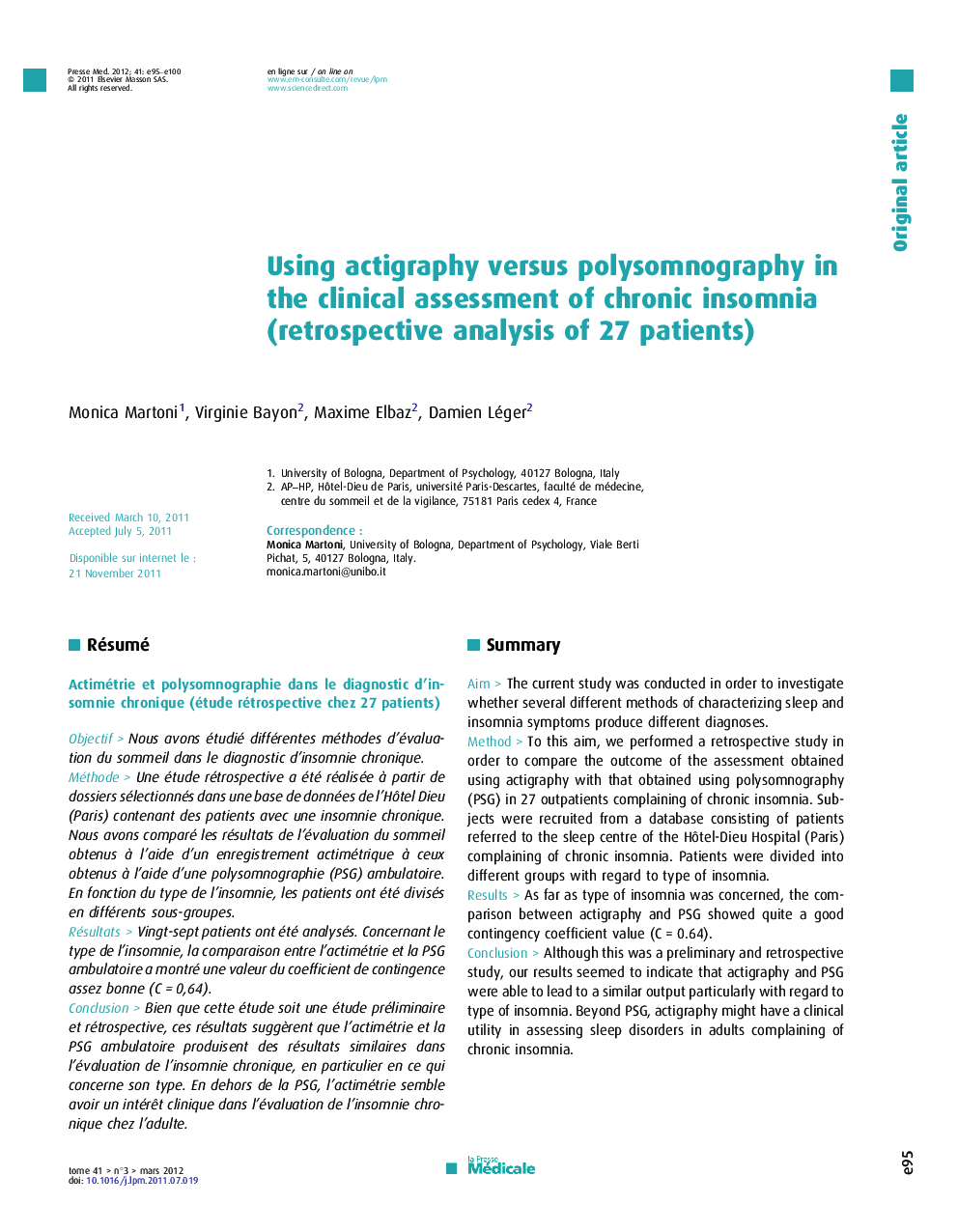| Article ID | Journal | Published Year | Pages | File Type |
|---|---|---|---|---|
| 3819952 | La Presse Médicale | 2012 | 6 Pages |
SummaryAimThe current study was conducted in order to investigate whether several different methods of characterizing sleep and insomnia symptoms produce different diagnoses.MethodTo this aim, we performed a retrospective study in order to compare the outcome of the assessment obtained using actigraphy with that obtained using polysomnography (PSG) in 27 outpatients complaining of chronic insomnia. Subjects were recruited from a database consisting of patients referred to the sleep centre of the Hôtel-Dieu Hospital (Paris) complaining of chronic insomnia. Patients were divided into different groups with regard to type of insomnia.ResultsAs far as type of insomnia was concerned, the comparison between actigraphy and PSG showed quite a good contingency coefficient value (C = 0.64).ConclusionAlthough this was a preliminary and retrospective study, our results seemed to indicate that actigraphy and PSG were able to lead to a similar output particularly with regard to type of insomnia. Beyond PSG, actigraphy might have a clinical utility in assessing sleep disorders in adults complaining of chronic insomnia.
RésuméObjectifNous avons étudié différentes méthodes d’évaluation du sommeil dans le diagnostic d’insomnie chronique.MéthodeUne étude rétrospective a été réalisée à partir de dossiers sélectionnés dans une base de données de l’Hôtel Dieu (Paris) contenant des patients avec une insomnie chronique. Nous avons comparé les résultats de l’évaluation du sommeil obtenus à l’aide d’un enregistrement actimétrique à ceux obtenus à l’aide d’une polysomnographie (PSG) ambulatoire. En fonction du type de l’insomnie, les patients ont été divisés en différents sous-groupes.RésultatsVingt-sept patients ont été analysés. Concernant le type de l’insomnie, la comparaison entre l’actimétrie et la PSG ambulatoire a montré une valeur du coefficient de contingence assez bonne (C = 0,64).ConclusionBien que cette étude soit une étude préliminaire et rétrospective, ces résultats suggèrent que l’actimétrie et la PSG ambulatoire produisent des résultats similaires dans l’évaluation de l’insomnie chronique, en particulier en ce qui concerne son type. En dehors de la PSG, l’actimétrie semble avoir un intérêt clinique dans l’évaluation de l’insomnie chronique chez l’adulte.What was known?•Insomnia is a very common sleep disorder that affects a very large number of people all over the world.•The primary care population has a higher prevalence of insomnia than the general population; insomnia and its management are topics of strong interest for General Practitioners who are interested in having information about sleep evaluation methods.•There are several methods for characterizing sleep and insomnia symptoms: objective methods (e.g. PSG) and subjective methods (e.g. sleep-log).What this study adds?•There are quite a few studies comparing actigraphy versus PSG in the clinical assessment of chronic insomnia, despite the high prevalence of insomnia in French population.•Beyond PSG and sleep-log, actigraphy can be used to assess the sleep/wake pattern, allowing subject to be objectively monitored in their habitual environment, over a period of days or weeks and at a lower cost than PSG.•Actigraphy might have a clinical utility in assessing sleep disorders in adults complaining of chronic insomnia.
